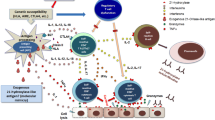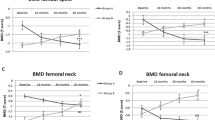Abstract
There are no consensus guidelines on the optimum long-term care of patients with primary adrenal failure. Published data suggest increased morbidity and mortality in patients treated with current therapy. Investigations of bone mineral density (BMD) in adults with adrenal failure have reported conflicting results. The objectives of this study were to determine the prevalence of auto-immune and other co-morbidities, describe the treatment regimens and to assess the BMD of adults with auto-immune Addison’s disease (AAD). A retrospective, cohort study of adults with primary adrenal failure was used. Electronic and paper records were used to collect demographic, biochemical, BMD data and details of other co-morbidities. 48 patients (35% male; 65% female; 50 ± 16, years, mean ± SD) with primary adrenal failure were identified. There was high prevalence of other auto-immune co-morbidities (hypothyroidism 58%, vitamin B12 deficiency 29%, type 1 diabetes 10%). The presence of cardiovascular risk factors including dyslipidaemia (65% had total cholesterol >5 mmol/l) and excess weight (65% had a BMI >25 kg/m2) were high. Using WHO criteria, 17.9 and 53.5% of patients had spinal osteoporosis and osteopenia, respectively, at the spine. This did not relate to the duration or dose of glucocorticoid replacement. Our data shows a high prevalence of both auto-immune and non-autoimmune co-morbidities in patients with AAD. In addition to common auto-immune diseases, patients should be screened for other cardiovascular risk factors. Further studies are needed to assess the cause of the observed increased prevalence of reduced BMD at the lumbar spine. There is a need for internationally agreed long-term management guidelines.
Similar content being viewed by others
References
W. Arlt, B. Allolio, Adrenal insufficiency. Lancet 361(9372), 1881–1893 (2003)
K. Lovas, E.S. Husebye, High prevalence and increasing incidence of Addison’s disease in western Norway. Clin. Endocrinol. (Oxf) 56(6), 787–791 (2002)
L. Leelarathna, J.K. Powrie, P.V. Carroll, Thomas Addison’s disease after 154 years: modern diagnostic perspectives on an old condition. Q. J. Med. (QJM) 102(8), 569–573 (2009)
K. Lovas, J.H. Loge, E.S. Husebye, Subjective health status in Norwegian patients with Addison’s disease. Clin. Endocrinol. (Oxf) 56(5), 581–588 (2002)
S. Hahner, M. Loeffler, M. Fassnacht et al., Impaired subjective health status in 256 patients with adrenal insufficiency on standard therapy based on cross-sectional analysis 2007. J. Clin. Endocrinol. Metab. 92(10), 3912–3922 (2007)
M.M. Erichsen, K. Løvås, B. Skinningsrud et al., Clinical, immunological, and genetic features of autoimmune primary adrenal insufficiency: observations from a Norwegian registry. J. Clin. Endocrinol. Metab. 94(12), 4882–4890 (2009)
R. Bergthorsdottir, M. Leonsson-Zachrisson, A. Oden et al., Premature mortality in patients with Addison’s disease: a population-based study. J. Clin. Endocrinol. Metab. 91(12), 4849–4853 (2006)
S. Bensing, L. Brandt, F. Tabaroj et al., Increased death risk and altered cancer incidence pattern in patients with isolated or combined autoimmune primary adrenocortical insufficiency. Clin. Endocrinol. (Oxf) 69(5), 697–704 (2008)
J.A. Kanis, L.J. Melton, C. Christiansen et al., The diagnosis of osteoporosis. Bone Miner. Res. 9(8), 1137–1141 (1994)
C.M. Florkowski, S.J. Holmes, J.R. Elliot et al., Bone mineral density is reduced in female but not male subjects with Addison’s disease. N. Z. Med. J. 107(972), 52–53 (1994)
P.M. Zelissen, R.J. Croughs, P.P. van Rijk et al., Effect of glucocorticoid replacement therapy on bone mineral density in patients with Addison disease. Ann. Intern. Med. 120(3), 207–210 (1994)
E. Jodar, M.P. Valdepenas, G. Martinez, Long-term follow-up of bone mineral density in Addison’s disease. Clin. Endocrinol. (Oxf) 58(5), 617–620 (2003)
G.D. Braatvedt, M. Joyce, M. Evans, Bone mineral density in patients with treated Addison’s disease. Osteoporos. Int. 10(6), 435–440 (1999)
E.M. Gurnell, P.J. Hunt, S.E. Curran et al., Long-term DHEA replacement in primary adrenal insufficiency. a randomized, controlled trial. J. Clin. Endocrinol. Metab. 93(2), 400–409 (2008)
G. Johannsson, R. Bergthorsdottir, A.G. Nilsson et al., Improving glucocorticoid replacement therapy using a novel modified-release hydrocortisone tablet: a pharmacokinetic study. Eur. J. Endocrinol. 161(1), 119–130 (2009)
M. Debono, C. Ghobadi, A. Rostami-Hodjegan et al., Modified-release hydrocortisone to provide circadian cortisol profiles. Clin. Endocrinol. Metab. 94(5), 1548–1554 (2009)
S. Marzotti, A. Falorni, Addisons’s disease. Autoimmunity 37, 333–336 (2004)
Author information
Authors and Affiliations
Corresponding author
Rights and permissions
About this article
Cite this article
Leelarathna, L., Breen, L., Powrie, J.K. et al. Co-morbidities, management and clinical outcome of auto-immune Addison’s disease. Endocr 38, 113–117 (2010). https://doi.org/10.1007/s12020-010-9359-8
Received:
Accepted:
Published:
Issue Date:
DOI: https://doi.org/10.1007/s12020-010-9359-8




